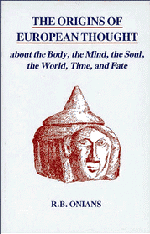Book contents
- Frontmatter
- Contents
- Preface to the first edition
- Preface to the second edition
- Introduction: The Earliest Greeks
- PART I THE MIND AND THE BODY
- Chapter I Some Processes of Consciousness
- Chapter II The Organs of Consciousness
- Chapter III The Stuff of Consciousness
- Chapter IV Cognition—The Five Senses
- Chapter V The Liver and the Belly
- PART II THE IMMORTAL SOUL AND THE BODY
- PART III FATE AND TIME
- ADDENDA
- Indexes
Chapter III - The Stuff of Consciousness
Published online by Cambridge University Press: 06 August 2010
- Frontmatter
- Contents
- Preface to the first edition
- Preface to the second edition
- Introduction: The Earliest Greeks
- PART I THE MIND AND THE BODY
- Chapter I Some Processes of Consciousness
- Chapter II The Organs of Consciousness
- Chapter III The Stuff of Consciousness
- Chapter IV Cognition—The Five Senses
- Chapter V The Liver and the Belly
- PART II THE IMMORTAL SOUL AND THE BODY
- PART III FATE AND TIME
- ADDENDA
- Indexes
Summary
What was the θυμός (thymos)? Evidently something vaporous (cf. e.g. θυμιάω). It has been interpreted by Gomperz and others after him as the ‘blood-soul’, receiving its name from the steam which rises from newly shed blood. Nägelsbach and Autenrieth have been followed by Bickel in referring it rather to the raging and boiling of the circulating blood, following the etymology of the Cratylus, ἀπὸ τῆς θύσεως καὶ зέσεως—not, however, for Plato of the blood but τῆς ψυχῆς—and thus losing the name's more natural and direct suggestion of something vaporous. Nor does Homer connect the θυμός directly with blood or make it behave as a mere ‘blood-soul’ should. It quits the body when no blood is spilt. Rohde speaks of the ‘untranslatable word θυμόςʾ, and says that it is not taken from any bodily organ and it shows already that it is thought of as an immaterial function, which, however, does not explain its origin and, unfortunately, is not true; for Homer's language makes it clear that it is not a function but a thing.
If the ϕρένες, in which the θυμός is said to be, are not the diaphragm but the lungs, it is no great leap of the imagination to guess that the θυμός itself is the breath, which may always be felt as vaporous and sometimes is visible. With it may be compared fumus, Sanscrit dhῡmaḥ, ‘vapour, smoke’, Old Slav. dymῠ, ‘smoke’, duchῠ, ‘breath, spirit’, etc.
- Type
- Chapter
- Information
- The Origins of European ThoughtAbout the Body, the Mind, the Soul, the World, Time and Fate, pp. 44 - 65Publisher: Cambridge University PressPrint publication year: 1988



